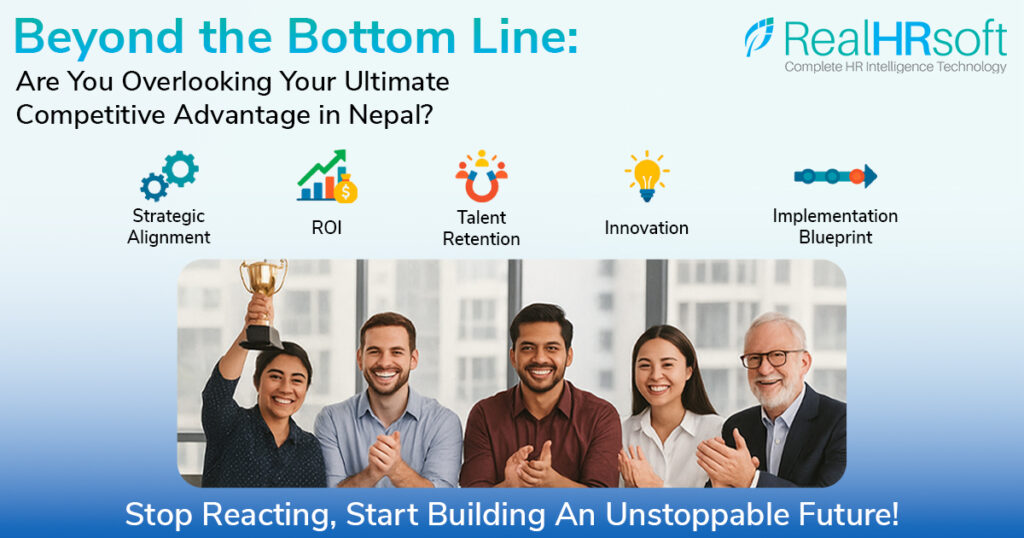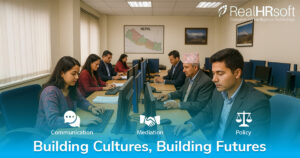Is Your Organization Truly Ready to Lead Nepal’s Future Economy?
In Nepal’s dynamic business arena, the conventional wisdom of cost-cutting and market maneuvering often overshadows the most profound truth: your most potent strategic asset walks in and out of your doors every single day. Your workforce isn’t just a cost center; it’s the engine of innovation, productivity, and sustainable competitive advantage.
For discerning business leaders and forward-thinking HR strategists across Nepal, the critical question is no longer if you need to engage your employees, but how you can transform their motivation into a direct, measurable driver of your organizational success. Are you merely managing personnel, or are you strategically cultivating a workforce that is deeply aligned with your vision, fiercely loyal, and relentlessly committed to your bottom line?
The Unseen Costs: Why Disengaged Talent Threatens Your Strategic Vision
The headlines often focus on market shifts, but the real threats to your strategic objectives can be far closer:
- The Talent Exodus: The persistent brain drain Nepal HR not only depletes your skilled workforce but imposes immense costs in recruitment, training, and lost institutional knowledge. Can your growth truly be sustainable without a stable, high-caliber team?
- Stagnant Productivity: A disengaged employee is a missed opportunity for innovation and efficiency. Are your teams operating at peak performance, or is hidden disinterest eroding your Nepali business productivity and hindering your ability to outmaneuver competitors?
- Weakened Employer Brand: In an increasingly transparent market, your reputation as an employer directly impacts your ability to attract future talent. Is your organization perceived as a destination for career growth, or merely a place to work?
These aren’t just HR problems; they are profound strategic vulnerabilities that directly impact your market share, profitability, and long-term viability. The stakes are too high for a reactive approach. But what if there was a proactive, proven strategy to convert these challenges into your greatest strengths?
The Strategic Goldmine: Orchestrating Reward & Recognition Programs for Maximum ROI
This is where a meticulously designed Reward & Recognition (R&R) program transcends basic HR and becomes a powerful strategic imperative. It’s not just about appreciating effort; it’s about systematically reinforcing behaviors that directly contribute to your organization’s VMGO (Vision, Mission, Goals, Objectives), driving performance excellence, and cementing an employer brand that attracts and retains the best. The objective? Tangible business outcomes: enhanced profitability, increased market competitiveness, and a culture of sustained high performance.
The Dual Engine: Financial Rewards – Driving Performance, Securing Stability
Financial incentives are the bedrock upon which high performance is built. They are critical for attracting top-tier talent, ensuring equitable compensation, and directly linking individual contribution to the company’s financial success. In the Nepali context, these elements are not just expected; they are a powerful statement of value.
- Performance Bonuses (Incentive Pay): Directly tying financial rewards to measurable individual, team, or organizational goals. These bonuses are a potent tool for driving accountability and achieving specific strategic objectives. They reinforce a culture of meritocracy and directly contribute to Nepali business productivity. For example, an incentive could be a predefined reward like NPR 10,000 for perfect attendance in a quarter, or a bonus for a team that completes a project ahead of schedule. Another common type is commission, which is a percentage of sales revenue awarded directly to an employee, often seen in sales roles.
- Dashain/Tihar Bonuses (Festival Bonuses): Beyond a legal mandate for many, this traditional annual bonus is a deeply cultural and significant financial gesture. It underscores the organization’s commitment to employee well-being and fosters profound loyalty, securing a competitive edge in Nepali business talent retention by recognizing cultural values.
- Annual Salary Increments: Regular, performance-based salary increases are fundamental to career progression and a strong indicator of an organization’s investment in its human capital. They are crucial for retaining high performers and maintaining a competitive position in the talent market.
- Profit Sharing: A powerful mechanism to align employee interests directly with the organization’s financial success. When employees share in the company’s prosperity, they gain a tangible stake in its growth, fostering collective responsibility and enhancing overall profitability through HR Nepal. This stake can come from direct payouts of profits, or through long-term ownership opportunities like Stock Options and Employee Stock Ownership Plans (ESOPs), which tie rewards to your tenure or key achievements.
- Provident Fund (PF) and Gratuity/ Social Security Fund (SSF): These statutory benefits demonstrate a long-term commitment to employee welfare and financial security. Transparent and efficient management of these funds enhances the employer’s reputation and contributes to a stable, committed workforce, reducing long-term HR costs.
- Spot Bonuses/Discretionary Bonuses: Agile and immediate cash awards for exceptional, ad-hoc contributions. These empower managers to provide timely financial reinforcement for behaviors that contribute to immediate strategic wins or demonstrate core company values.
Beyond the Balance Sheet: Non-Financial Recognition – Cultivating Loyalty, Fueling Innovation
While financials attract, non-financial rewards inspire. These elements tap into deeper human desires for purpose, growth, and belonging, creating an organizational culture that is resilient, innovative, and uniquely Nepali. They cultivate a thriving office environment that money alone cannot buy.
- Strategic Growth & Development Opportunities: Investing in Skill Development Programs Nepal, leadership training, cross-functional projects, and mentorship signals a commitment to long-term career progression. This directly addresses the brain drain Nepal HR challenge by providing compelling pathways for professional growth within the organization.
- Meaningful Public Recognition: Acknowledging achievements in a respected forum (e.g., CEO recognition at a town hall, “Values Champion” awards) provides powerful social validation. When delivered with sincerity and cultural sensitivity (mindful of shyness), it reinforces desired behaviors and strengthens the employer brand.
- Flexible Work Arrangements & Work-Life Balance: Offering flexible hours or remote work options demonstrates trust and an understanding of employees’ lives outside of work, particularly their central family values. This strategic flexibility boosts morale, reduces stress, and enhances productivity, directly impacting workforce engagement Nepal.
- Enhanced Work Environment & Culture: Creating a psychologically safe, supportive, and engaging workplace through team-building, open communication, and well-being initiatives. A strong sense of community fosters loyalty and reduces turnover, acting as a powerful non-monetary retention tool.
- Increased Autonomy & Strategic Responsibility: Empowering high-potential employees with greater control over their work or opportunities to lead critical projects signals trust and investment. This cultivates future leaders and fosters a sense of ownership in strategic outcomes.
- Direct Feedback & Mentorship: Providing constructive, actionable feedback and formal mentorship programs aligns with the Nepali cultural value of respect for guidance. This accelerates individual growth, enhances performance, and builds a stronger leadership pipeline.
- Support for Family & Community: Initiatives that extend benefits or recognition to an employee’s family or involve community service deeply resonate with Nepali cultural values. This fosters profound loyalty and positions the organization as a responsible corporate citizen.
Your Strategic Playbook: A Step-by-Step Implementation Blueprint for Sustainable Growth
This isn’t just a checklist; it’s a strategic roadmap for integrating R&R into your core business operations, ensuring measurable ROI and sustained competitive advantage.
Phase 1: Strategic Alignment & Foundation
- Define Clear Strategic Objectives: Articulate how the R&R program will directly contribute to your company’s overarching VMGO (e.g., “Achieve a 15% increase in core product sales by enhancing sales team motivation,” “Reduce top talent attrition by 10%”).
- Conduct a Strategic Workforce Motivation Audit: Beyond basic preferences, delve into why certain rewards resonate. Understand cultural nuances, career aspirations, and financial needs specific to your Nepali workforce to ensure strategic impact.
- Identify High-Impact Behaviors: Define specific, measurable behaviors that, when reinforced, will directly drive your strategic objectives (e.g., “consistent innovation in product development,” “exceptional customer satisfaction leading to referrals”).
- Strategic Budget & Resource Allocation: Allocate resources as a strategic investment, projecting clear ROI. Consider not just financial costs but also the organizational time and HR technology (like an HRIS software) required for robust program management.
Phase 2: Program Architecture & Development
- Architect Diverse Recognition Mechanisms: Develop a balanced portfolio of financial (performance bonuses, Dashain/Tihar Bonuses, profit sharing) and non-financial (growth opportunities, public recognition, flexible work) rewards. Each element should serve a clear strategic purpose.
- Develop Transparent Policies: Craft clear, concise policies that define eligibility, criteria, and delivery for all reward types. Transparency is critical for building trust and ensuring the program’s perceived fairness.
- Integrate with Strategic HRIS & Performance Management: Seamlessly embed R&R into your Performance Management System and HRIS software. Leverage HR analytics software to track program effectiveness, identify trends, and demonstrate ROI.
- Develop Strategic Communication & Leadership Training: Create a compelling narrative for the program’s launch and ongoing communication, highlighting its strategic purpose. Crucially, train leaders and managers on how to strategically use both financial and non-financial recognition to drive desired behaviors and outcomes.
Phase 3: Strategic Activation & Ongoing Management
- Strategic Program Launch: Position the launch as a key organizational initiative, led by senior management, to underscore its strategic importance and secure widespread buy-in.
- Empower Managers as Strategic Enablers: Equip managers to be on-the-ground champions, utilizing both formal financial and daily, informal non-financial recognition to reinforce strategic behaviors consistently.
- Continuous Strategic Feedback Loop: Implement mechanisms to regularly solicit feedback from employees and managers on the program’s effectiveness, focusing on its impact on motivation, performance, and overall strategic alignment.
Phase 4: Strategic Evaluation & Continuous Optimization
- Measure Strategic Impact & ROI: Beyond simple metrics, track the program’s correlation with key business outcomes: Employee Engagement Scores, Nepali business talent retention rates, productivity improvements, innovation pipeline growth, and ultimately, profitability.
- Annual Strategic Review & Refinement: Conduct a comprehensive annual review, analyzing data and feedback to strategically refine the program. Ensure it remains aligned with evolving business objectives, market dynamics, and employee needs, maximizing its long-term strategic value.
Cultural Intelligence: Weaving Your Program into the Nepali Fabric
For maximum strategic impact, your R&R program must be deeply rooted in Nepali culture:
- Collective Acknowledgment: While individual success is celebrated, recognition that acknowledges team-based efforts often resonates more powerfully, reinforcing harmony and shared success.
- Respect for Authority: Recognition delivered by senior leadership carries immense weight and reinforces organizational values.
- Sincere Appreciation: Balance public recognition (mindful of laaj) with heartfelt, private acknowledgment. The genuine nature of the gesture holds profound value.
- Family-Centric Benefits: Benefits that extend to the family are deeply appreciated and build unwavering loyalty, positioning your organization as a truly caring employer.
- Festival Alignment: Strategic recognition linked to Dashain, Tihar, or Nepali New Year amplifies impact and cultural relevance.
- Growth Mindset: Opportunities for skill development and career progression are highly valued, demonstrating a commitment to employees’ long-term professional journey.
Strategic Pitfalls to Avoid: Don’t Undermine Your Investment
- Misalignment with Strategic Goals: An R&R program that doesn’t clearly support business objectives is an expense, not an investment.
- Inconsistent Application: Perceived unfairness or favoritism will erode trust and negate all strategic intent.
- Lack of Leadership Buy-in: Without active leadership championship, the program will lack credibility and strategic weight.
- Ignoring Feedback: A static program, unresponsive to employee needs or strategic shifts, will quickly become obsolete.
- Over-reliance on a Single Reward Type: A truly strategic program leverages the synergistic power of both financial and non-financial incentives.
Your Call to Action: Unleash Your Workforce’s Full Strategic Potential!
In today’s dynamic Nepali business landscape, a strategic, integrated Reward & Recognition program is no longer a luxury; it’s a fundamental pillar of sustainable growth and competitive advantage. It’s about cultivating a culture where every employee is a strategic partner, deeply invested in your organization’s success.
Are you ready to transform your HR function from a cost center into a strategic powerhouse? To stop losing talent and start building an unbreakable, high-performing team?
Take the first step: Audit your current R&R strategy against your core business objectives. Engage your leadership. And dare to build a reward system that truly reflects the strategic value of your greatest asset: your people.
The future of your Nepali enterprise leadership depends on it. Let’s strategically empower your workforce and build a legacy of unparalleled success!
Reach out to us for customized Reward and Recognition Program consulting in Nepal and expert HR consulting services!
info@aayulogic.com +977-9802-075555





